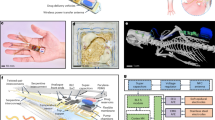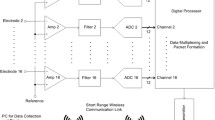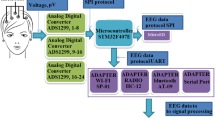Abstract
Electroencephalography (EEG) of small animal models of brain disorders is the powerful method of neurophysiology that requires efficient, low cost and flexible instrumentation. Most of the commercially available EEG systems for small animals are not flexible enough and do not allow for task-specific modifications, while custom systems developed for a specific task are typically hard to be reproduced because of its specific design.We propose a modular EEG platform with Bluetooth low energy wireless interface that features both implantable and tethered use and allows for easy task-specific adaptation. To illustrate the proposed designapproach, we present a low-cost autonomous instrument for photobiomodulation of mouse brain during deep sleep.



Similar content being viewed by others
Data availability
Not applicable.
Code availability
Notapplicable.
References
S. Calafate, G. Özturan, N. Thrupp, J. Vanderlinden, L. Santa-Marinha, R. Morais-Ribeiro, J. de Wit, Early alterations in the MCH system link aberrant neuronal activity and sleep disturbances in a mouse model of Alzheimer’s disease. Nat. Neurosci.Neurosci. 26(6), 1021–1031 (2023)
S. Rahimi, A. Soleymankhani, L. Joyce, P. Matulewicz, M. Kreuzer, T. Fenzl, M. Drexel, Discriminating rapid eye movement sleep from wakefulness by analyzing high frequencies from single-channel EEG recordings in mice. Sci. Rep. 13(1), 9608 (2023)
Z.P. Chen, S. Wang, X. Zhao, W. Fang, Z. Wang, H. Ye, C. Yan, Lipid-accumulated reactive astrocytes promote disease progression in epilepsy. Nat. Neurosci. 26(4), 542–554 (2023)
F. Motolese, J. Lanzone, A. Todisco, M. Rossi, F. Santoro, A. Cruciani, F. Pilato, The role of neurophysiological tools in the evaluation of ischemic stroke evolution: a narrative review. Front. Neurol. 14, 1178408 (2023)
D. Li, S. Liu, T. Yu, Z. Liu, S. Sun, D. Bragin, D. Zhu, Photostimulation of brain lymphatics in male newborn and adult rodents for therapy of intraventricular hemorrhage. Nat. Commun.Commun. 14(1), 6104 (2023)
T. Yamanashi, J.R. Malicoat, K.T. Steffen, K. Zarei, R. Li, B.S. Purnell, G. Shinozaki, Bispectral EEG (BSEEG) quantifying neuro-inflammation in mice induced by systemic inflammation: a potential mouse model of delirium. J. Psychiatr. Res. 133, 205–211 (2021)
Y. Medlej, R. Asdikian, L. Wadi, H. Salah, L. Dosh, R. Hashash, M. Obeid, Enhanced setup for wired continuous long-term EEG monitoring in juvenile and adult rats: application for epilepsy and other disorders. BMC Neurosci. 20(1), 1–12 (2019)
Ouyang, W., Lu, W., Zhang, Y., Liu, Y., Kim, J. U., Shen, H., & Rogers, J. A.: A wireless and battery-less implant for multimodal closed-loop neuromodulation in small animals. Nature Biomedical Engineering, 1–18(2023).
T. Yoshikawa, H. Sato, K. Kawakatsu, T. Tateno, Low-Cost Electroencephalographic Recording System Combined with a Millimeter-Sized Coil to Transcranially Stimulate the Mouse Brain In Vivo. JoVE 195, e65302 (2023)
A. Zayachkivsky, M.J. Lehmkuhle, F.E. Dudek, Long-term continuous EEG monitoring in small rodent models of human disease using the epoch wireless transmitter system. JoVE 101, e52554 (2015)
Lundt, A., Wormuth, C., Siwek, M. E., Müller, R., Ehninger, D., Henseler, C., &Weiergräber, M.: EEG radiotelemetry in small laboratory rodents: a powerful state-of-the art approach in neuropsychiatric, neurodegenerative, and epilepsy research. Neural Plasticity, 2016 (2016).
O. Semyachkina-Glushkovskaya, I. Fedosov, A. Zaikin, V. Ageev, E. Ilyukov, D. Myagkov, D. Tuktarov, I. Blokhina, A. Shirokov, A. Terskov, D. Zlatogorskaya, V. Adushkina, A. Evsukova, A. Dubrovsky, M. Tsoy, V. Telnova, M. Manzhaeva, A. Dmitrenko, V. Krupnova, J. Kurths, Technology of photobiostimulation of brain’s drainage system during sleep for improvement of learning and memoryin male mice. Biomed. Optics. Express. 15(1), 44–58 (2024)
K. Lidster, J.G. Jefferys, I. Blümcke, V. Crunelli, P. Flecknell, B.G. Frenguelli, M.J. Prescott, Opportunities for improving animal welfare in rodent models of epilepsy and seizures. J. Neurosci. Methods 260, 2–25 (2016)
C. Guo, G.J. Blair, M. Sehgal, F.N. Sangiuliano Jimka, A. Bellafard, A.J. Silva, D. Aharoni, Miniscope-LFOV: A large-field-of-view, single-cell-resolution, miniature microscope for wired and wire-free imaging of neural dynamics in freely behaving animals. Sci. Adv. 9(16), eadg3918 (2023)
C. Guo, A. Wang, H. Cheng, L. Chen, New imaging instrument in animal models: two-photon miniature microscope and large field of view miniature microscope for freely behaving animals. J. Neurochem. 164(3), 270–283 (2023)
K. Aulehner, J. Bray, I. Koska, C. Pace, R. Palme, M. Kreuzer, H. Potschka, The impact of tethered recording techniques on activity and sleep patterns in rats. Sci. Rep. 12(1), 3179 (2022)
V. Jakubcakova, C. Flachskamm, R. Landgraf, M. Kimura, Sleep phenotyping in a mouse model of extreme trait anxiety. PLoS ONE 7(7), e40625 (2012)
Funding
E.I., D.M., D.T., S.P., I.B., A.T., V.A., D.Z. were supported by RSF № 23–75-30001.
Author information
Authors and Affiliations
Contributions
EI initiated and supervised this article. IT and VT wrote Abstract and Conclusions; Introduction, Results and Conclusions; MZ made the statistical analysis; IB, AE, DZ, VA, AT performed most experiments. All authors were also involved in the editing of the manuscript; SP prepared the figures. All authors were also involved in the editing of the manuscript; IB prepared the figures. All authors have read and agreed to the published version of the manuscript.
Corresponding author
Ethics declarations
Conflict of interest
The authors declare that they have no competing interests.
Ethics approval
All experimental procedures were performed in accordance with the “Guide for the Care and Use of Laboratory Animals”, Directive 2010/63/EU on the Protection of Animals Used for Scientific Purposes, and the guidelines from the Ministry of Science and High Education of the Russian Federation (No. 742 from 13.11.1984), which have been approved by the Bioethics Commission of the Saratov State University (Protocol No. 7).
Consent to participate
Not applicable.
Consent for publication
Not applicable.
Rights and permissions
Springer Nature or its licensor (e.g. a society or other partner) holds exclusive rights to this article under a publishing agreement with the author(s) or other rightsholder(s); author self-archiving of the accepted manuscript version of this article is solely governed by the terms of such publishing agreement and applicable law.
About this article
Cite this article
Ilyukov, E., Myagkov, D., Tuktarov, D. et al. Task-specific approach in customized design of EEG system for small laboratory animals. Eur. Phys. J. Spec. Top. (2024). https://doi.org/10.1140/epjs/s11734-023-01082-2
Received:
Accepted:
Published:
DOI: https://doi.org/10.1140/epjs/s11734-023-01082-2




